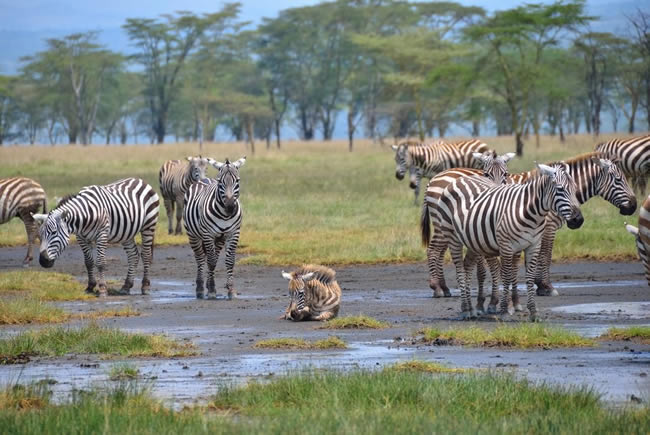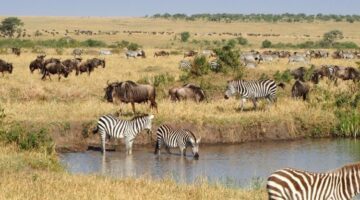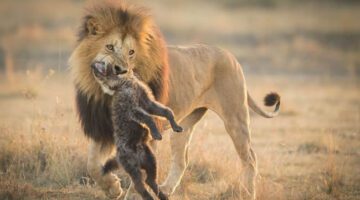...
Lake Nakuru National Park
Lake Nakuru National Park is one of Kenya’s protected areas situated 164 kilometers northwest of Kenya’s Capital city Nairobi on the floor of the Great Rift Valley covering an area of 188square kilometers near Nakuru town. Lake Nakuru National Park was established in 1961 and named after its famous Lake “Nakuru” a Masai language phrase that means “dust or dusty place”. This protected area started off small only encompassing the famous Lake and the surrounding mountain vicinity but has since been extended to include a large part of savannahs.
Several mammals such as Rothschild’s giraffes in 1980s were introduced to the Park to diversify it from a bird sanctuary to also animal viewing destination. In 1984, Lake Nakuru National Park was declared the first government protected rhino sanctuary in Kenya having introduced both black and white Rhinoceros. Lake Nakuru National Park is best known for millions of flamingos and other several bird species nesting along the Lake’s shores making it one of the world’s greatest bird spectacle. Lake Nakuru National Park was therefore declared a RAMSAR Site in 1990 and an internationally reorganized Important Birding Area in 2009. 
Attractions in Lake Nakuru National Park
Lake Nakuru
Lake Nakuru is a shallow soda Lake that was once a single and deep freshwater Lake with Lake Naivasha and Lake Elementaita that eventually dried up leaving the three Lakes as remnants. It is after Lake Nakuru that Nakuru National Park was named after it had been established as an Important Birding Area. Lake Nakuru covers an area of about 45square kilometers with alkaline shores that attract a large number of flamingos and other bird species making it a birder’s paradise. Lesser and greater flamingos can easily be spotted from the Park’s viewpoints such as the lion hill and the baboon cliff. Many other bird species and various mammals can as well be spotted congregating at the Lake shores.
Bird species
Lake Nakuru National Park is listed among the Important Birding Areas in Kenya housing to about 500bird species including those that are endemic to the region, critically endemic and globally threatened bird species. Bird species that thrive in Lake Nakuru National Park include lesser flamingos, great snipe, crowned eagle, European roller, pallid harrier, grey-crested helmeted shrike, maccoa duck, white headed vulture, rueppell’s griffon, Abyssinian thrush, grey-crowned cranes, common ostrich, Egyptian goose, northern shoveler, northern pintail, tufted duck, coqui francolin, speckled pigeon, ring-necked dove, black-faced sandgrouse, black-bellied bustard, white browned coucal, red-knobbed coot, spur-winged lapwing, greater painted snipe, wood sandpiper, common redshank, grey-hooded gull, marabou stork, yellow-billed stork, long-tailed cormorants, pink-backed pelican, great white pelican, hammerkop, goliath heron, great egret, black headed heron, little egret, cattle egret, squacco heron, African sacred ibis, osprey, African fish eagle, steppe eagle, greater spotted eagle, imperial eagle, spotted eagle-owl, speckled mouse bird, African grey hornbill, malachite kingfishers, white-fronted bee-eater, lesser honey guide, lesser kestrel, black cuckoo shrike, white helmeted shrike, bush-shrikes, red-capped lark, bank swallows, barn swallows to mention but a few.
Mammals and other wildlife
Lake Nakuru National Park is a home to a variety of mammals including four out of Africa’s big five animals namely rhinos, buffaloes, lions and leopards. This National Park is recognized as one of a few National Parks in Kenya hosting large concentrations of both the eastern black rhinoceros and southern white rhinos. Other mammals include Rothschild’s giraffe, warthogs, hippopotamuses, Thomson’s gazelles, Burchell’s zebra, waterbucks, hyenas, cheetahs and many more. Lake Nakuru National Park as well houses several primates such as olive baboons, vervet monkeys, black and white colobus monkeys to mention but a few.
Hills
Lake Nakuru National Park constitutes of several hills that contribute to its rugged terrain which act as wildlife viewing spots suitable for capturing and enjoying the Park’s wildlife. These hills include the lion hill, Enasoit, honey moon and many more.
Makalia waterfalls
Lake Nakuru National Park houses a stunning and magnificent waterfall that forms a plunge pool with water steadily dropping off a 10 meter sheer cliff. This waterfall lies along Makalia river located in the southern end of the Park. The waterfall offers stunning beauty and a perfect place for photography.
Rivers and beautiful scenery
Lake Nakuru National Park has a water supply that is channeled from several Rivers for example Enderit River, Makalia River and Njoro River. Other than Rivers, this National Park offers beautiful scenery that ranges from the Rift valley escarpments that rises from the Lake to Lake Nakuru that is all year round dotted with pink flamingos.
Activities in Nakuru National Park
Birdwatching
Lake Nakuru National Park is a birdwatching destination harboring to about 500 bird species that are easily spotted during a bird watching excursion. Bird watching is done in the southern sector of the Park along the shores of Lake Nakuru as well as its surrounding areas. Lake Nakuru is birding hotspot that attracts several bird species such as lesser and greater flamingos, herons, grey-headed kingfishers, pied kingfishers, hammerkops, pelicans, storks and many more. Bird watching in Lake Nakuru National Park can as well be from the Park’s vintage viewing spots other than the Lake.
Game viewing
Game viewing is done during game drives both day and night, horse riding safaris in the Park as well as cycling where several animals are spotted up-close. An experienced driver guide takes on a four wheel tourist vehicle through the Park’s savannah plains while you look out for several animals such as lions, buffaloes, giraffes, rhinos, leopards, gazelles, zebras, warthogs and many more. Other than the Park’s savannah grasslands, several animals can as well be spotted along Lake Nakuru shores as they congregate to quench their thirst.
Nature walks and hikes
Lake Nakuru National Park offers opportunities to visitors to make hikes for example to the Makalia waterfalls which is a hidden treasure within the Park situated along Makalia River. The hike looks a bit strenuous since it requires some physical fitness as well as some hiking experience though rewarding upon encountering the waterfalls where scenic beauty is captured.
Camping and picnicking
Lake Nakuru National Park provides the best opportunities for camping due to its ragged terrain and vegetation that offer raised and best placements for one’s camping tents. The Park is also perfect for camping due to its favorable weather conditions that are neither so hot nor so cold. The Park is also a perfect spot for picnics with several picnic spots that are entirely raised above the Park ground levels offering delightful views of animals, bird species and beautiful scenery. The Park’s picnic sites include Baboon cliff, out of Africa outlook, lion cliff and many more.
Best time to visit Nakuru National Park
Lake Nakuru National Park receives visitors all year round though the perfect and best time for its visit is during the dry season in the months of June to September and December to February. During this period, the vegetation cover is light and temporary water sources always dry up forcing animals to congregate around Lake Nakuru which makes game viewing easy. This National Park is also flocked with numerous bird species during the dry season including migratory birds compared to the wet season.
Top Kenya Destinations
BOOK OUR CURATED SAFARIS
Add Uganda and Rwanda to your travel list this year as we are offering a fantastic tailor-made tours to individual and small groups



